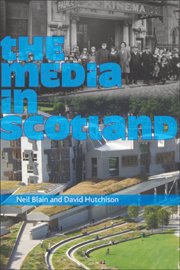Book contents
- Frontmatter
- Contents
- Preface
- Framing the Discussion
- The Historical Context
- Screen and Sound
- Themes and Futures
- 12 Gender, Spaces, Changes: Emergent Identities in a Scotland in Transition
- 13 Race and Ethnicity in the Media
- 14 Gaelic, the Media and Scotland
- 15 The Scottish Media and Politics
- 16 A View from Westminster
- 17 A View from Holyrood
- 18 Media Sport
- Select Bibliography
- Notes on Contributors
- Index
17 - A View from Holyrood
from Themes and Futures
Published online by Cambridge University Press: 05 August 2013
- Frontmatter
- Contents
- Preface
- Framing the Discussion
- The Historical Context
- Screen and Sound
- Themes and Futures
- 12 Gender, Spaces, Changes: Emergent Identities in a Scotland in Transition
- 13 Race and Ethnicity in the Media
- 14 Gaelic, the Media and Scotland
- 15 The Scottish Media and Politics
- 16 A View from Westminster
- 17 A View from Holyrood
- 18 Media Sport
- Select Bibliography
- Notes on Contributors
- Index
Summary
On election day I always vote early at home in Argyll before hotfooting it to the South of Scotland and my own constituency. On 3 May 2007, having exercised my choice as MSP in favour of my friend and colleague Jim Mather (who won) and my choice as First Minister in favour of Alex Salmond (ditto), I set off to cross the Clyde and stopped at a newsagent's in Sandbank near Dunoon. Scanning the counter I felt a thrill of excitement - could it really be that The Sun, which had become the most hostile of cheerleaders for Gordon Brown's ‘nat bashing’, was suddenly re-converted to the cause of independence, which it left fifteen years ago? Surely it must be so, I thought, as I looked at the huge SNP symbol on its front page?
Reality dawned quickly. The symbol was indeed there, but cleverly altered to resemble a noose. A number of other small symbols, redrawn in the same way, emphasised the point. Voting SNP today, the paper was telling its readers, would be an act of individual and collective suicide.
Such a brutal lack of subtlety was hardly surprising. The day before the paper had carried a double page spread which encouraged voters in a range of marginal constituencies to cast their ballots tactically in order to defeat every significant nationalist candidate. Labour, Tory and Liberal voters were urged to put country before their party (that country being Britain of course) in order to see off the subversive, impoverishing and no doubt scrofulous nationalists.
- Type
- Chapter
- Information
- The Media in Scotland , pp. 248 - 252Publisher: Edinburgh University PressPrint publication year: 2008



